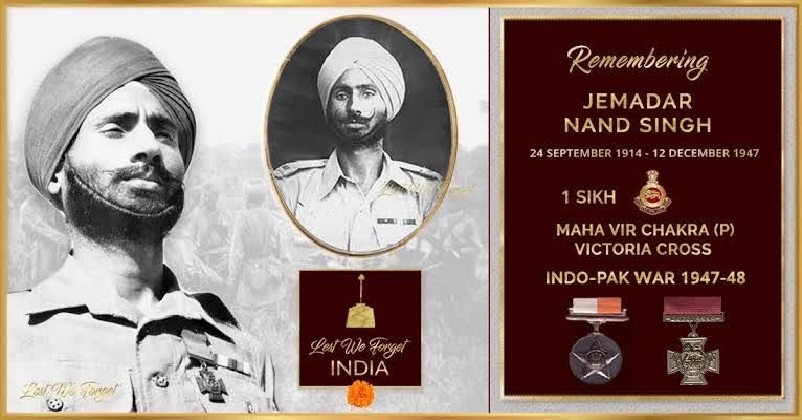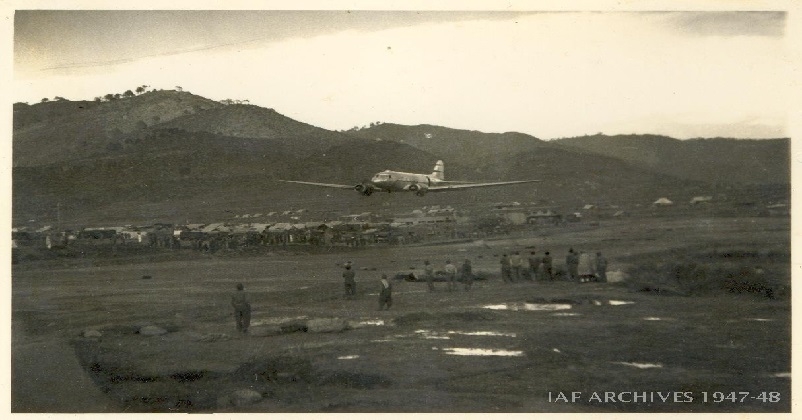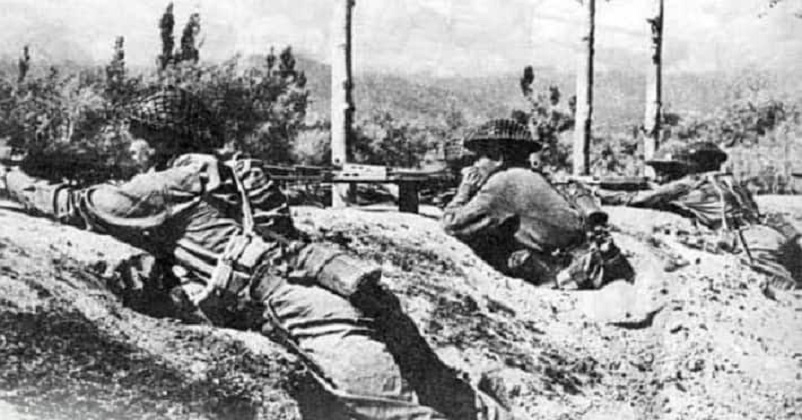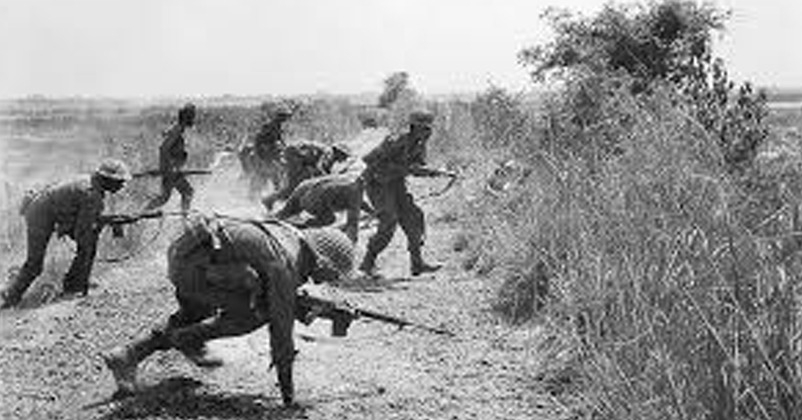History #Revision : India’s loss of Jhangar in 1947-48’s Pakistani invasion of Jammu and Kashmir ( Article 8)
06 Dec 2022 14:33:35

Loss of Jhangar (December 1947)
While Army Headquarters was finalising the future plans, the situation in Jammu and Kashmir appeared fairly well stabilised. Enemy sniping continued, however, and local skirmishes were a regular feature of the limited operations which lasted from 27 November to 9 December. From 10 December, the tempo of activity increased. The enemy became more aggressive and directed his attacks against the vulnerable Indian line of communication (Jammu-Jhangar), culminating in his capture of Jhangar on 24 December and the fierce but unsuccessful attack on Naushahra on 26 December. Indian efforts were largely concentrated on consolidating the position at Uri, warding off enemy attacks on Poonch and guarding the vulnerable line of communication.
URI SECTOR
Some 4000 to 6000 raiders were estimated to be operating in Uri sector. Many wore serge battle-dress and the force was reported to include some men from Pakistan's South Waziristan Scouts. The methods employed by these men, including their system of defences, indicated that they had been trained and were being led by professional soldiers They employed a large number of 3-inch mortars. 161 Infantry Brigade held in strength the forward position at Uri. The following troops constituted the garrison of Uri.
Headquarters 161 Brigade
Squadron 7 Cavalry 1 Sikh
4 Kumaon
Company 1 (Para) Kumaon
Company 1/1 Punjab (Indian elements)
Company 1 Mahar (medium machine gun) less one platoon One troop 32 Field Battery
One platoon 32 Assault Field Company
3 Light Field Ambulance
4 Field Surgical Team
Some re-grouping of the Uri garrison was carried out and the defence of the perimeter strengthened 1 Sikh was withdrawn from the perimeter into reserve, and 4 Kumaon took their place towards the end of November 1947. 2 Dogra was spread along the line of communication from Baramulla to Uri. Srinagar garrison consisted of 6 Rajputana Rifles and odds and ends of rear parties of 161 Infantry Brigade and State Force elements in the Badambagh Cantonment.
4 Kumaon manned the piquets at Uri As there was a concentration of about a thousand enemy in the area Gohalan-Thajal, the picquets were mainly on the ridge which led south to Sank. D company had picquets named Jitter and Jitterbug, while still further south B company manned the forward picquet called Diamond. It was the forward picquet of Diamond on the Sank ridge which had to bear the brunt of enemy attacks. On 1 December 1947 the enemy attacked this picquet, the attack lasted from 1630 hours to 1930 hours, but was repulsed, with 25 hostiles killed and 25 wounded. The defenders lost one Naik and one Sepoy was wounded On 6 December, enemy switched the attack to a picquet across the Jhelum. The enemy was engaged by medium machine guns and dispersed. Following up this success, A company manning this picquet sent out on 8 December a fighting patrol to the village Mukdam Sayidan.
On 10 December, 4 Kumaon made an attempt to clear the enemy from part of the Sank ridge. D company (Dogras) and a platoon from B company advanced from picquet Diamond to attack the enemy in village Muhri Doba. The attack was very successful, encouraged by this success, C company, holding a spur of the main Sank ridge, made a daring attempt to attack the enemy position on the adjoining spur C company was supported by a platoon from 1(Para) Kumaon. The attack yielded good results-about 80 hostiles were killed and 50 wounded. Indian casualties were 5 killed. The hostiles hit back and launched an attack at 2030 hours on the same day with two companies on picquet Jitter, but were repulsed.
THE BHATGIRAN AFFAIR
A concentration of the raiders was reported on the high hills overlooking Uri from the south-east. The raiders heavily sniped the Uri garrison and posed a threat to the roads leading from Uri towards Srinagar and towards Poonch, so it was decided to dislodge them from those hills and 1 Sikh (less A coy) moved out at 0700 hrs on 12 December from Uri, led by the CO, Lieut-Colonel Sampuran Bachan Singh. The Sikhs found no difficulty in brushing aside the opposition in the area of the enemy's outer picquets, and reached the main enemy position along the top of the ridge.
What happened then, and why, is far from clear. All that can be said with certainty is that, when the battalion started moving back to Uri by a different route down the hill side, the raiders suddenly opened fire from three sides. The B coy under Major Ajaib Singh, which was leading the way back, was pinned down and was extricated with difficulty after a desperate fight by a platoon of D coy under Jem Nand Singh, a veteran of World War I and the winner of the Victoria Cross. There was confused and fierce fighting, and heavy losses were inflicted and suffered. Jem Nand Singh earned a Maha Vir Chakra to add to his Victoria Cross, but fell in the battle, riddled by an LMG burst from close quarters.

Lieut-Colonel Sampuran Bachan Singh, and Major Ajaib Singh, both received bullet wounds, and the total casualties suffered by 1 Sikh were 1officer. 2 Junior Commissioned Officers and 57 other Ranks killed. and 2 officers,4 JCOs and 5O others wounded .The battalion was left in no position to undertake any further operations for some time. Enemy casualties were estimated to total about 300 killed and 500 wounded.
The withdrawal of 1 Sikh was facilitated by an inspiring example of courage and skill shown by the Boysplatoon of 4 Kumaon. This platoon was the only reserve available at Uri when news reached there of this fierce enemy attack on 1 Sikh. The platoon was rushed up to the picquet line and skilfully deployed there by the platoon commander. The Sikhs withdrew through the platoon, and the raiders following them up suddenly found themselves under murderous fire from well-sited positions. Many of them were mowed down before the rest collected their wits and fled back the way they had come.
After the engagement at Bhatgiran, enemy continued his pressure on the piquets, especially Jitter and Jitterbug. On 13 December, the picquet Jitterbug was jittered by a small enemy party. After an exchange of small arms fire the raiders melted away. Next day a platoon attacked picquet Jitter. The raiders bumped against booby traps, suffered casualties and retired in confusion. Undeterred by this failure, one company of hostiles renewed the attack on picquet Jitter on 15 December. They were mortared and machine gunned and dispersed .There was then a lull for about three days, On 19 December approximately 60 hostiles attacked both the picquets, Jitter and Jitterbug. After an engagement, which lasted for twenty minutes, they retired in confusion.
Some reorganisation of 161 Brigade then took place. As the fighting efficiency of 1 Sikh had suffered due to heavy losses in the engagement at Bhatgiran, the battalion was relieved by 6 Rajputana Rifles and moved to Srinagar for rest. The relief was completed by 2 December, although one of the companies was still detained at Baramulla Srinagar garrison as such was dissolved and Colonel Harbakhsh Singh took over the command of 1 Sikh, in addition to carrying out the duties of Station Commander, Srinagar.
POONCH BRIGADE
The Poonch garrison, consisting of approximately 2000 State Force troops, had been reinforced by 1 (Para) Kumaon (less one com- pany) in November 1947. On 10 December, the Poonch garrison was set up as a brigade to be known as Poonch Brigade. The estimated strength of the enemy in the Poonch sector was about 3000. The use of automatics and mortars by the hostiles liberally almost every day indicated that they were receiving a regular supply of ammunition. Intelligence reports revealed that they were bringing the ammunition over the Lachman Pattan bridge, west of Palandri. The main approaches to Poonch open to the raiders were two, i.e , Palandri-Poonch track and Garhi-Bagh route, the latter was reported fit for mechanical transport.
RIAF considerably helped the Poonch garrison by attacking enemy positions and thus blunting the edge of their attacks. The Tempests and Harvards based at Jammu flew offensive reconnaissance over Poonch, which helped to raise the morale of the garrison. On 4 December, the Tempests subjected enemy positions north-east and north-west of Poonch, as indicated by the ground forces, to 20 mm cannon fire. Then again, on 7 December, enemy positions in the immediate vicinity of Poonch were engaged by rockets and 20 mm cannon. On 8 December, a Dakota successfully dropped supplies over Poonch. On the same day, enemy targets north of Poonch were bombed with good results. On 9 December, a Dakota dropped ammunition supplies to the garrison at Poonch. On 12 December, a Dakota engaged on dropping ammunition supplies to the garrison at Poonch was shot up from the hills to the west of Poonch, but landed safely at Poonch.

To facilitate aregular flow of supplies, Brigadier Pritam Singh, Commander, Poonch Brigade, decided to construct an airstrip. Hundreds of refugees worked hard to complete it. With the completion of the airstrip, supplies could be landed at Poonch instead of having to be air dropped. Even heavy or fragile equipment not suitable for air dropping could now reach Poonch. On 13 December, the RIAF landed a section of Mountain Battery. The arrival of the guns eased the situation a good deal, for the enemy was compelled to withdraw his mortars out of the range of the guns and the town was spared further shelling.
On 14 December the Dakotas flew 1 sorties from Jammu to Poonch, carrying small arms, ammunition and supplies weighing about 29,940 kg. The returning aircraft carried from Poonch to Jammu 35 civilian casualties and 80 sick State Force troops. Henceforth the Dakotas were almost continuously employed, carrying food and ammunition supplies from Jammu to Poonch. The weather, however, was not always kind, rain often rendered Jammu airfield unserviceable but even this could not deter the RIAF from its momentous task and, as an alternative, supplies were earned from Amritsar.
By carrying food and ammunition supplies and by attacking frequently enemy positions, the RIAF undoubtedly played a significant role in helping the beleaguered garrison of Poonch to hold out against the persistent attacks. The mountain guns airlifted to Poonch were worth their weighting gold. The infantry, supported by the guns, won an initial success when they attacked and captured a hill south of Poonch during night 12/13 December. The enemy had been occupying these hills since 3 December and had prepared well dug-in positions. The loss of this hill chagrined the raiders a good deal and the tempo of their attacks increased considerably during 16-18 December.
The Indian piquets were well sited to meet the threat. South of the Poonch river, a ridge spread out like an arc, rising to a succession of peaks from Pt. 5024 through Pt 6005 to Pt 6876 (Pir Margot Ghazi). From this main ridge, many spurs jutted out towards the Poonch river like the fingers of a hand. On one of these spurs leading through Baran Gala were two picquets .To the right on the adjoining spur, was a third picquet with a fourth picquet on the next spur. These picquets on the three main spurs were sited to prevent an enemy attack developing from the south of Poonch North of Poonch, the picquets were sited on the right and west of the Betar Nala, On the right of the Betar Nala, a ridge stretched like a bow, with one end touching Poonch and another sloping to Chuhana spring, with the middle curve around Pt 7416.
The piquets were sited on the spur which branched off from this ridge at Pt 5052 West of the Betar Nala, there was a main ridge which rose in successive peaks--Pt 4024, Pt.5724, Pt 6455 and Pt. 7819. The piquets were sited on the spur which branched off from Pt 5724 and forked into two. All these piquets were mortared and attacked during 16-18 December. The attacks were repulsed mainly with the support of the mountain guns which took a heavy toll of the enemy. Then the attacks gradually petered out The Poonch Brigade had weathered the storm.
JHANGAR FALLS
Although the hostiles kept up pressure at Uri and Poonch and also attempted to cut off the vulnerable Indian line of communication, it was against Jhangar that their main effort was directed Jhangar was of strategic importance since it was the junction of the roads from Mirpur and Kotli. By capturing Jhangar, the Indian troops had cut off the enemy's line of communication from Mirpur to Kotli and Poonch. The hostiles were determined to retake Jhangar.
After the evacuation of Kotli at the close of November 1947, 50 Para Brigade concentrated at Naushahra, 1/2 Punjab was however left at Jhangar with the following under command.
One troop A squadron 7 Cavalry (4 armoured cars)
One platoon YCompany 1Mahar (MMG) (4 medium machineguns) Detachment 14 Field Company Engineers
One company 33 Field Ambulance
Detachment 50 Para Brigade Signal Section
50 Para Brigade Light Aid Detachment
The commander of 1/2 Punjab took steps to site piquets to command the approaches to Jhangar from Mirpur and Kotli. The holding of Pir Matals ridge was of the utmost importance to meet the enemy threat from Mirpur. Hence one company with two medium machine guns and a detachment of mortars was positioned there. Another company was put on its flank at a lower height, but on the same line of ridges which stretched towards Naushahra. The remaining two companies were scattered all round on piquets which numbered about ten. Most of these picquets were on the ridge which commanded the approaches to Jhangar from Kotli. Unfortunately the ground did not afford opportunities for these piquets to be inter-supporting. The distance between them varied from 450 metres to 720 metres.
The defence was in the shape of a basin with the cross roads in the centre Armoured cars were used mostly for road opening operations, and from the road itself they could hardly support any defensive positions. From the beginning of December 1947, enemy increased the pressure on Jhangar Piquets were kept engaged continuously On 9 December, the raiders launched a powerful attack on the Pir Matalsi ridge. They came in superior numbers and managed to come as near as 45 metres of the Indian positions. The attack was, however, repulsed and the enemy retired, leaving 40 dead behind. Further attacks appeared likely, but unfortunately, no early reinforcements were possible.

On the day (16 December) that the Indian column advanced from Naushahra towards Chingas, the enemy stopped and engaged a convoy from Jhangar to Naushahra at a roadblock at milestone 12. On 19 December, the enemy was successful in disrupting temporarily the line of communication. A convoy of 25 vehicles proceeding from Naushahra towards Akhnur was held up at 1430 hours at a spot, where a bridge had been destroyed and the road had been blocked. The convoy was attacked by about 300 enemy with rifles and automatics. The last vehicle of the column turned back to Ben Pattan and reported the incident. A platoon of 3 (Para) Rajput from Beri Pattan arrived at 1530 hours when fighting was still going on. The column was extricated and brought back. Indian casualties were 1 officer and 16 Other Ranks missing. On the same day at 2100 hours, the piquets of 1/2 Punjab at Jhangar were heavily mortared and simultaneously attacked. The attack lasted till 0330 hours on 20 December, when it was finally repulsed.
The next enemy attack on Jhangar on 24 December was well planned. His coordination and timings for this particular plan were very near perfect. For a week before his attack the enemy kept on sending small parties at night to feel the defences. After these preliminary operations, enemy cut off the line of communication and then launched an attack on Jhangar. Thus prior to his attack on Jhangar the enemy succeeded in putting strong roadblocks on roads Jhangar-Naushahra and Beri Pattan-Chauki. On the morning of 23 December, a troop of armoured cars N o 2) escorting a convoy carrying rations and ammunition and one company 1 Rajput from Naushahra to Jhangar encountered one such roadblock 6 km west of Naushahra, and came under very heavy fire from ridges north and south of the road at 1000 hours. Another troop of armoured cars (No 1) proceeding from Jhangar towards Naushahra also encountered a similar roadblock at about the same time Both the columns got involved in very heavy fighting Enemy strength in this area was approximately 1500 men armed with mortars, light machine guns, rifles and hand grenades.
They succeeded in working their way to the rear of both the columns and blew up the two bridges in the rear of each column, thus cutting off their way of retreat Now there were four roadblocks, which kept the two troops of armoured cars approximately 900 metres apart Infantry did not support the armoured cars but went down the Nala. At 1600 hours, 1 Rajput less one company, which had been assigned the task of protecting the left flank of the convoy from area Kaman Gosha Gala, returned to Naushahra and at once proceeded to help the hard pressed convoy.
They also got involved in the fighting and were not successful in bringing back the armoured cars due to broken culverts, though they extricated their own company by 1800 hours.The company commander was wounded, 3 Indian Other Ranks were killed and 3 were missing. Meanwhile the armoured cars were still locked up in battle with the enemy on the roadblocks. The crews of all the four armoured cars fought all day and night. Troop leader Jemadar Umrao Singh (No 2 troop) fought very bravely and killed at least 200 enemy. The armoured cars repulsed half-a-dozen determined attacks by the enemy during the might 23/24 December, although enemy anti-tank rifles damaged the armoured cars to a considerable extent.
Having been successful in blocking the road Naushahra-Jhangar and preventing reinforcements, enemy attacked Jhangar in great strength in the morning of 24 December. The first attackcame in from the south-west at 0630 hours and was carried out with great determination by a force of 2000. The weak company holding the position on the Pir Matalsi ridge, unprotected by barbed wire, was over-run by the large number of attackers, in spite of scores of them falling down due to fire from the valiant defenders. They came in wave after wave with complete disregard to casualties. The machine gunners worked havoc, but they were cut to pieces while still firing the guns.
It was estimated that enemy suffered nearly 1000 casualties, but within an hour he had seized the Pir Matals ridge. The company in flank being at a dominated place, could not last long. By dayhght the whole of the ridge was in enemy hands. The enemy put in a second attack from the north-west with an approximate strength of 1000 at 0730 hours. With the vital Pir Matals ridge in enemy hands, the remnants of the other two companies were put on the small local features on the cross roads, but they could not do much to stem the rot. Jhangar was now completely surrounded and inter-communication between Jhangar and Naushahra was disrupted at 0740 hours.
Mortar ammunition was by then exhausted, the enemy had occupied the intermediate features between the cross roads and the Pir Matals ridge. The commander of the garrison was faced with two alternatives-either to hold on and get completely annihilated or to withdraw to Naushahra. He decided on the latter alternative. All available transport which could be loaded was sent back but this was lost on the roadblocks. The remnant of the garrison began to trickle to Naushahra in small parties.
Meanwhile the armoured cars at the roadblocks on the road Naushahra-Jhangar had recommenced their battle against the hostiles at 0700 hours. On 24 December Troops had very nearly expended all their ammunition No 1 troop (ex Jhangar) however managed to come past the abandoned convoy and joined up with No 2 troop. It came further towards Naushahra when, immediately after passing over a bridge, the wheel of the front armoured car shipped off the road. The second armoured car trying to pull this one out also got ditched. The crews had to abandon the armoured cars at 1200 hours and arrived at Naushahra by approximately 1400 hours. The troop leaders made an attempt to recover the armoured cars with the help of a breakdown lorry, but were unsuccessful. Guns from the two armoured cars were, however, removed. The recovery party returned to Naushahra at 1800 hours.

While all these events were taking place, an attempt was made to send a relief column from Naushahra to Jhangar. A column of 1 Rajput less one company, a section of mountain artillery and a section of medium machine guns left Naushahra at 0700 hours on 24 December. In order to avoid the enemy on the road, the column took a route south of the road but its advance was held up 3 km south-west of Naushahra by approximately 3000 hostiles, occupying strong positions at Nothi Dhar and surrounding features.
A savage battle was fought the whole day to get through, but owing to the enemy's advantageous position on commanding features, the column was eventually pinned to the ground By 1400 hours, the remnants of the Jhangar garrison, who were being followed by the enemy from Jhangar, were arriving on the scene and with the help of the relief column managed to fight their way to Naushahra. On approach of darkness the reinforcement column also broke off engagement and fell back on Naushahra.
The hostiles followed up their success at Jhangar by an attack on Naushahra at 1800 hours. On 25 December About 3000 raiders were concentrated all round the camp. Parties of the enemy also by-passed Naushahra and proceeded towards Beri Pattan to cut off the line of communication. The camp was heavily mortared. The enemy made two attempts to infiltrate into the camp at 1900 hours and 2100 hours on 25 December. Both the attempts were foiled. Several enemy attempts to rush the picquets were also repulsed. The enemy broke off engagement on approach of daylight and concentrated in Nothi Dhar and Shan Da Mohra features in the south-west and Kot, north-east of Naushahra. Their strength in the immediate vicinity of line of communication Naushahra-Beri Pattan was estimated to be between 2500-3000 and approximately 5000 in area between Naushahra and Jhangar.
Offensive air support was not possible on 24 December due to bad weather, as a result of which the Tempests at Jammu were grounded. Offensive air support was given on 25 December, from Jammu Ammunition dumps and enemy concentrations were fiercely strafed and bombed, which undoubtedly blunted the edge of further attacks.
The loss of Jhangar was a serious setback Indian casualties in men and material were heavy. Two officers and 58 Other Ranks were killed, three officers, two Junior Commissioned Officers and 51 Other Ranks were wounded, and 42 Other Ranks were reported missing Equipment lost in action included five 3-inch mortars, four medium machine guns, fourteen light machine guns, twelve 2-inch mortars, seventy rifles, four armoured cars and a number of other vehicles The tragic story of the loss of Jhangar is, however, illuminated by the reckless heroism of a handful of machine gunners (a platoon of 1 Mahar) who stuck to their posts and continued to fire and take heavy toll of the enemy until they were overwhelmed and cut to pieces.
(Excerpts have been taken from "History of Operations in Jammu and Kashmir 1947-48")